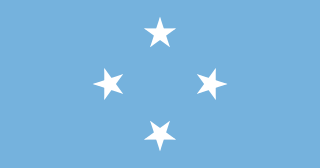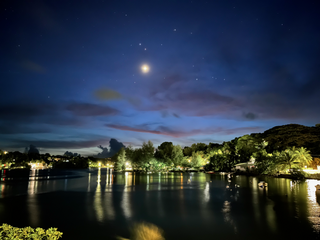
The Federated States of Micronesia are located on the Caroline Islands in the western Pacific Ocean. The history of the modern Federated States of Micronesia is one of settlement by Micronesians; colonization by Spain, Germany, and Japan; United Nations trusteeship under United States-administered Trust Territory of the Pacific Islands; and gradual independence beginning with the ratification of a sovereign constitution in 1979.

A rai stone, or fei stone, is one of many large artifacts that were manufactured and treasured by the native inhabitants of the Yap islands in Micronesia. They are also known as Yapese stone money or similar names.

The traditional music of the Federated States of Micronesia varies widely across the four states, and has, in recent times, evolved into popular music influenced by Europop, country music and reggae.
Yapese is an Austronesian language in the Oceanic branch spoken on the island of Yap, in the Federated States of Micronesia. It has been difficult to classify the language further, but Yapese may prove to be one of the Admiralty Islands languages. The Yapese language refers to the language spoken specifically on the Yap Main Islands, and does not include the Chuukic languages spoken in the Yap Neighboring Islands: Ulithian, Woleaian, and Satawalese.

Yap State is one of the four states of the Federated States of Micronesia, located in the westernmost portion of the country. The state borders Palau to the southwest, Guam to the north, and Chuuk State to the east. According to the state's population census carried out in 2020, the total population is 11,577 residing across a total area of 119.54 sq km, though a large majority of the area is water. The only town area in the state, Colonia, serves as the state capital.

Colonia is an urban area between the municipalities of Rull and Weloy which serves as the capital of Yap State, one of the states in the Federated States of Micronesia. It’s not to be confused with Kolonia, the capital of Pohnpei State. It administers both Yap proper and some 13 atolls and islands reaching to the east and south for some 800 kilometers.

Rull is a municipality in the southern part of the island Yap, Federated States of Micronesia. It has a traditional dancing ground. Rull has a population of 1,847. The historic Rull Men's Meetinghouse is located within the town.

Yap traditionally refers to an island group located in the Caroline Islands of the western Pacific Ocean, a part of Yap State. The name "Yap" in recent years has come to also refer to the state within the Federated States of Micronesia, inclusive of the Yap Main Islands and its various outer islands, the Yap Neighboring Islands. For specifying the island group, the name Yap Main Islands is most exact.

Tomil or Tamil is a municipality on the island of Yap, in the Federated States of Micronesia. It consists of twelve distinctive villages: Meerur, Teb, Aff, Bugol, Doomchuy, Deechmur, Dilag, Maa', Thol, Madl'ay, Gargey, and Daaboch. Tomil occupies the southern portion of Gagil-Tamil Island, except for Gargey village, which is located on the main island of Yap.

Dalipebinau is a village and municipality in the state of Yap, Federated States of Micronesia. It lies on the west side of the Yap island, north of Yap International Airport.

Gagil is a municipality in the state of Yap. It forms part of Gagil-Tamil Island and covers the eastern side of the island. It has a population of roughly 400 people scattered in village groups. One of these villages includes the village of Gachpar which was once the capital of the historic Yap Islands Empire that lasted from about 10th to the 15th century AD and stretched as far as east as the west halls of Chuuk Lagoon, as far south as the northern atolls of Papua New Guinea, and as far west as the outer islands of Palau. The Yap Islands Empire centered in Gagil and it, and the Tui Tonga Empire of Tonga, are the only empires that existed in the ancient history of the Pacific Islands.

Weloy is a village and municipality in the state of Yap, Federated States of Micronesia.

Maap is an island and village and municipality in the state of Yap, Federated States of Micronesia. It lies on the north east of the archipelago of Yap.

Gilman is a village and municipality in the state of Yap, Federated States of Micronesia. It lies on the south side of the Yap island. Six villages or hamlets are integrated there : Anoth, Gachlaw, Guror, Magchagil, Thabeth and Towoway. The population was 252 in 2010.
Tarang, also known as O'Keefe's Island is a small island in the main harbor of Yap Island in the Federated States of Micronesia. It is located roughly in the center of the harbor east of Colonia, the Yapese capital, between Pekel and Bi Islands. It is a low island with a maximum height of about 22 feet (6.7 m), and is overgrown with tropical vegetation. The island has local historical importance as the home of Captain David O'Keefe, an enterprising American who arrived on Yap in the 1870s, and was responsible for not only significant economic growth, but also for the depreciation of the distinctive Yapese currency, the large rai stones which became devalued after O'Keefe introduced iron tools that made manufacture of the stones easier. O'Keefe settled on Tarang, where he had a boat landing, coal warehouse, and house. Of these structures, only the boat landing has survived; only foundations survive of the others.

The Yapese people are a Micronesian ethnic group native to the main island of Yap. Yapese culture is built on the maxim: Respect and Responsibility. Aspects of traditional Yapese culture are still important in modern Yapese culture.
Religion in Yap is predominantly Roman Catholic, which first arrived in Yap in the late 1880s. Before that, the Yapese people practiced traditional rituals and practices and held beliefs about the gods, the spirits, taboos, and death. Through the efforts of Capuchin and Jesuit missionaries, the Catholic Church eventually became the dominant church on Yap. Other religions on Yap include Protestantism and other Christian sects.

The Church of Jesus Christ of Latter-day Saints in the Federated States of Micronesia refers to the Church of Jesus Christ of Latter-day Saints and its members in the Federated States of Micronesia (FSM). The church's first known missionaries arrived on July 5, 1978. As of December 31, 2022, there were 5,966 members in 23 congregations in FSM. The LDS Church has congregations in every state in the FSM.
Yap Living History Museum is a museum in Colonia, Yap, in the Federated States of Micronesia. It is a living history museum which is dedicated to Yapese culture.
The traditional councils of the Yap State are two assemblies of traditional leaders: the Pilung Council for the chiefs of the Yap Islands and the Tamol Council for the chiefs of the Outer Yap Islands. They have been established in 1992 by the Constitution of the Yap State, within the Federated States of Micronesia. The executive, the legislative, the judiciary and the traditional councils are the four institutional branches of government in the Yap State, but the councils, unlike the others, transcend the concept of the separation of powers. The councils are responsible for exercising the functions that relate to tradition and custom, which are not required to be recorded in the written law. In the Yap State, custom and tradition prevail over any interpretation of the constitution and even over any judicial decision. The councils have the right to veto legislation that they consider to be contrary to traditional practices. The constitutionality of these councils and their veto power could be challenged under the Micronesian Federal Constitutional Law, but to this date no one has done it.








